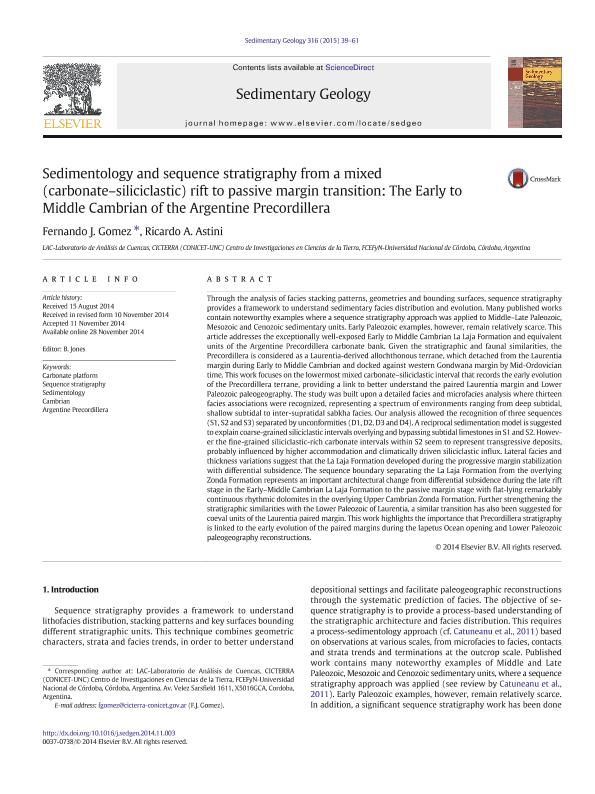Mostrar el registro sencillo del ítem
dc.contributor.author
Gomez, Fernando Javier

dc.contributor.author
Astini, Ricardo Alfredo

dc.date.available
2018-03-05T18:47:32Z
dc.date.issued
2015-03
dc.identifier.citation
Gomez, Fernando Javier; Astini, Ricardo Alfredo; Sedimentology and sequence stratigraphy from a mixed (carbonate-siliciclastic) rift to passive margin transition: The early to middle cambrian of the argentine precordillera; Elsevier Science; Sedimentary Geology; 316; 3-2015; 39-61
dc.identifier.issn
0037-0738
dc.identifier.uri
http://hdl.handle.net/11336/37813
dc.description.abstract
Through the analysis of facies stacking patterns, geometries and bounding surfaces, sequence stratigraphy provides a framework to understand sedimentary facies distribution and evolution. Many published works contain noteworthy examples where a sequence stratigraphy approach was applied to Middle-Late Paleozoic, Mesozoic and Cenozoic sedimentary units. Early Paleozoic examples, however, remain relatively scarce. This article addresses the exceptionally well-exposed Early to Middle Cambrian La Laja Formation and equivalent units of the Argentine Precordillera carbonate bank. Given the stratigraphic and faunal similarities, the Precordillera is considered as a Laurentia-derived allochthonous terrane, which detached from the Laurentia margin during Early to Middle Cambrian and docked against western Gondwana margin by Mid-Ordovician time. This work focuses on the lowermost mixed carbonate-siliciclastic interval that records the early evolution of the Precordillera terrane, providing a link to better understand the paired Laurentia margin and Lower Paleozoic paleogeography. The study was built upon a detailed facies and microfacies analysis where thirteen facies associations were recognized, representing a spectrum of environments ranging from deep subtidal, shallow subtidal to inter-supratidal sabkha facies. Our analysis allowed the recognition of three sequences (S1, S2 and S3) separated by unconformities (D1, D2, D3 and D4). A reciprocal sedimentation model is suggested to explain coarse-grained siliciclastic intervals overlying and bypassing subtidal limestones in S1 and S2. However the fine-grained siliciclastic-rich carbonate intervals within S2 seem to represent transgressive deposits, probably influenced by higher accommodation and climatically driven siliciclastic influx. Lateral facies and thickness variations suggest that the La Laja Formation developed during the progressive margin stabilization with differential subsidence. The sequence boundary separating the La Laja Formation from the overlying Zonda Formation represents an important architectural change from differential subsidence during the late rift stage in the Early-Middle Cambrian La Laja Formation to the passive margin stage with flat-lying remarkably continuous rhythmic dolomites in the overlying Upper Cambrian Zonda Formation. Further strengthening the stratigraphic similarities with the Lower Paleozoic of Laurentia, a similar transition has also been suggested for coeval units of the Laurentia paired margin. This work highlights the importance that Precordillera stratigraphy is linked to the early evolution of the paired margins during the Iapetus Ocean opening and Lower Paleozoic paleogeography reconstructions.
dc.format
application/pdf
dc.language.iso
eng
dc.publisher
Elsevier Science

dc.rights
info:eu-repo/semantics/openAccess
dc.rights.uri
https://creativecommons.org/licenses/by-nc-sa/2.5/ar/
dc.subject
Argentine Precordillera
dc.subject
Cambrian
dc.subject
Carbonate Platform
dc.subject
Sedimentology
dc.subject
Sequence Stratigraphy
dc.subject.classification
Meteorología y Ciencias Atmosféricas

dc.subject.classification
Ciencias de la Tierra y relacionadas con el Medio Ambiente

dc.subject.classification
CIENCIAS NATURALES Y EXACTAS

dc.title
Sedimentology and sequence stratigraphy from a mixed (carbonate-siliciclastic) rift to passive margin transition: The early to middle cambrian of the argentine precordillera
dc.type
info:eu-repo/semantics/article
dc.type
info:ar-repo/semantics/artículo
dc.type
info:eu-repo/semantics/publishedVersion
dc.date.updated
2018-03-02T14:01:06Z
dc.journal.volume
316
dc.journal.pagination
39-61
dc.journal.pais
Países Bajos

dc.journal.ciudad
Amsterdam
dc.description.fil
Fil: Gomez, Fernando Javier. Consejo Nacional de Investigaciones Científicas y Técnicas. Centro Científico Tecnológico Conicet - Córdoba. Centro de Investigaciones en Ciencias de la Tierra. Universidad Nacional de Córdoba. Facultad de Ciencias Exactas Físicas y Naturales. Centro de Investigaciones en Ciencias de la Tierra; Argentina
dc.description.fil
Fil: Astini, Ricardo Alfredo. Consejo Nacional de Investigaciones Científicas y Técnicas. Centro Científico Tecnológico Conicet - Córdoba. Centro de Investigaciones en Ciencias de la Tierra. Universidad Nacional de Córdoba. Facultad de Ciencias Exactas Físicas y Naturales. Centro de Investigaciones en Ciencias de la Tierra; Argentina
dc.journal.title
Sedimentary Geology

dc.relation.alternativeid
info:eu-repo/semantics/altIdentifier/url/https://www.sciencedirect.com/science/article/pii/S0037073814002024
dc.relation.alternativeid
info:eu-repo/semantics/altIdentifier/doi/http://dx.doi.org/10.1016/j.sedgeo.2014.11.003
Archivos asociados
